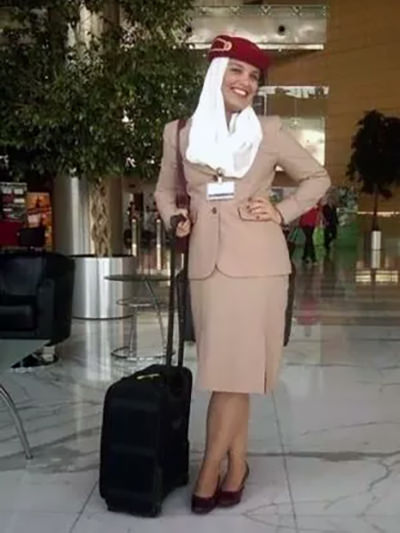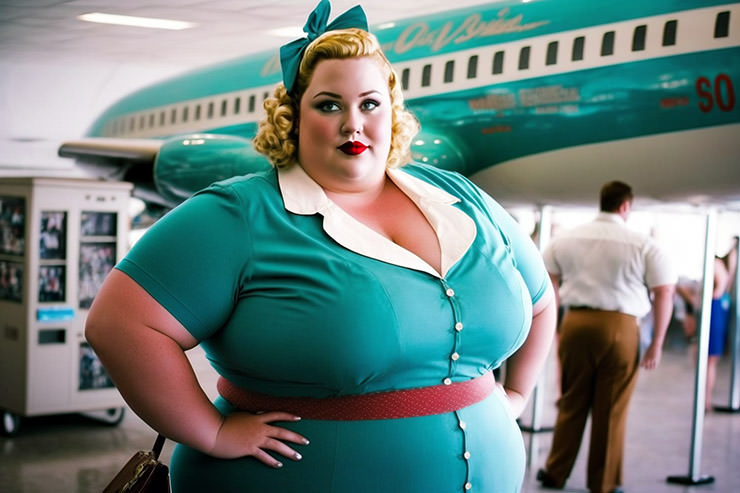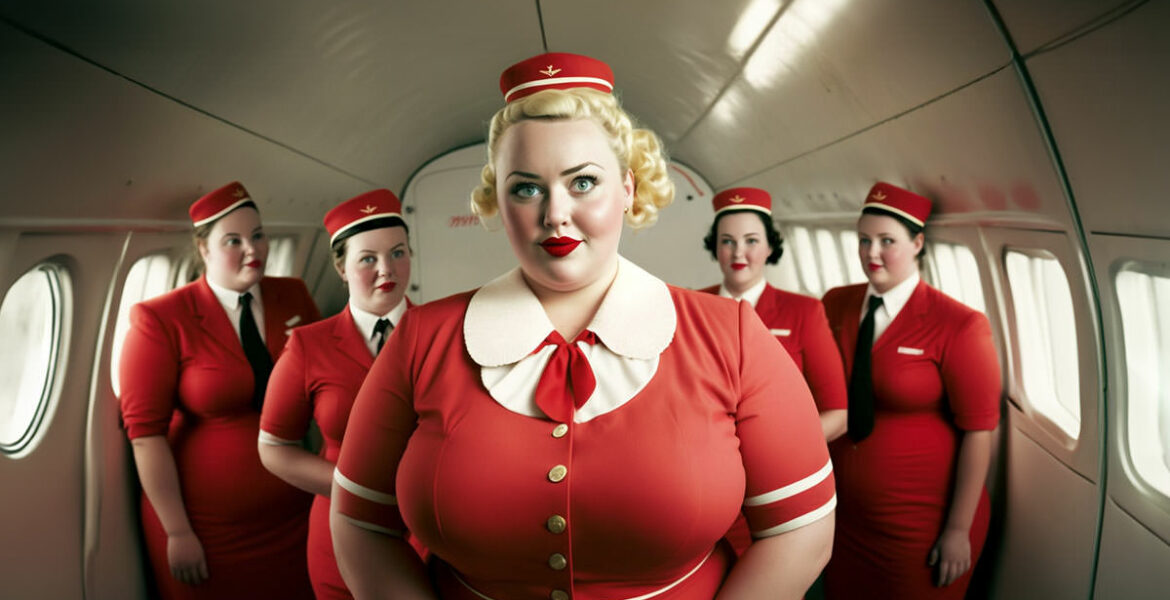In an industry where every extra kilogram of luggage could become a costly affair, weight-related concerns have a gravitational pull. Overweight passengers on flights, squeezed in minuscule seats, already know the peculiar difficulties of air travel and fat-shaming it often comes with. But does the same apply to a cabin crew? Can a flight attendant be fat? Or better: Can a fat person be a flight attendant?
Many airlines still draw their tolerance line in front of plus-size cabin crew members
You might think that the topic is outdated and that discrimination based on body size was already fought through by the flight attendants of the 1960s and 1970s. But many airlines worldwide are stuck in a time warp and still cling to not always realistic appearance standards.
Sure, there have been certain improvements toward inclusivity and diversity on planes in recent years. United Airlines shook things up by giving the green light for employees of all genders to flaunt makeup, nail polish, and the natural flow of their hair. British Airways encouraged pride and authenticity permitting all staff to sport mascara, false eyelashes, and piercings. Most recently, Qantas scrapped male-female uniform designations and allowed their cabin crew to grow long hair, wear makeup and jewelry, and ultimately be themselves.
While Western airlines are finally unshackling themselves from gender-based policies, there are still many companies that draw their tolerance line right in front of plus-size cabin crew members. Fat flight attendants might find themselves grounded based on their appearance, with little regard for their actual job skills.
So can flight attendants be fat? Do cabin crew weight and height requirements truly keep us safe in the skies? Do airlines even hire plus-size cabin crew? What are the most fat-friendly airlines? Find the answers in this guide to the world of overweight flight attendants!
If they don't let you work as a flight attendant, learn how to become a pilot!
From runway to runway – sex sells seats

Post-World War II, in an era of fierce airline rivalry, flying was sold not just as a mode of transport, but a lifestyle – glamorous and exclusive, a jet-setter’s privilege. The advertised always-smiling and endlessly accommodating flight attendant in the 50s and 60s was seen as one of the most desired professions for women.
The illusion came at a price. To maintain the image of a petite, obedient servant, rigid physical examinations were a seasonal pressure. That created anxiety and even eating disorders.
Fuel prices skyrocketed in the 1960s, and airlines, desperate to lure male customers, decided to sex things up, turning stewardesses into objects.
One of the first such campaigns was the cringe-worthy Air Strip, a 1965 ad by Braniff International Airways, promising a disrobing in-flight entertainment.

To keep up with the expectations set by marketing campaigns, airlines enforced strict weight/height ratios for their flying elite. In an age when Twiggy became a fashion icon, measuring bust, waist, and hips became a routine part of flight attendant job interviews, and “extremely slim” was the norm.

The US stewardesses protested against the meat market. When the Civil Rights Act was passed in 1964, with Title VII guaranteeing equal employment opportunity without discrimination, they started filing numerous lawsuits.
This didn’t deter airlines from their business as usual. In 1971, National Airlines launched the Fly Me campaign, a spectacular display of sexism that doubled their passenger growth percentage compared to the industry standard.
The stereotype was embraced by other airlines too. Southwest Airlines delivered its “Sex Sells Seats” motto by dressing hostesses in hot pants and go-go boots, while advertising “love with no strings attached”.
Cabin crew weight requirements – fight or flight
Ann Hood, who joined the TWA as a flight attendant in the late 1970s, offers a glimpse of this world in her memoir, “Fly Girl”. She reveals that air hostesses were trying a variety of questionable weight-loss techniques, from excessive water drinking and experimenting with diuretics to following bizarre diets that had you eating nine bananas one day, nine eggs the next, and nine hot dogs on the third.

“Imagine a gaggle of tall, pretty, thin young women sitting in the sauna at the YMCA of Boston, trying to sweat off pounds. Ridiculous when you consider that by most people’s standards, we were already considered underweight. But, scared of losing our jobs, that’s exactly what we did”, Hood wrote.
Flight attendants had had enough and they formed unions to actively combat workplace discrimination. One such legal battle with American Airlines dragged on for 17 years, finally reaching a settlement in 1991. The airline agreed that cabin crew didn’t need to maintain the same weight they had at 21.
Mostly because of the pricy settlements, the US airlines started to abandon the old flight attendant weight requirements in the 1990s. While most Western cultures embraced the body positivity movement, carriers in Asia and the Middle East still restrict access to the profession on the basis of belt size.

The weight war decade of plus-size crew
The past decade has seen a rather weighty war unfold in the airline industry, particularly in the Eastern skies. Companies have been on a crusade against what they consider fat flight attendants. The battle shows no signs of a smooth landing.
2015 – Air India’s not-so-happy meal
In 2015, Air India put 600 flight attendants on a strict diet and exercise regimen for being overweight. The airline set body mass index limits at 22 for women, and 25 for men, effectively declaring 125 cabin crew members permanently unfit for duty.
The Indian Supreme Court rejected requests to ban weight limits.
In 2017, Air India grounded an additional 57 crew members, and in 2021, they even introduced airport weigh-ins for their staff before boarding.
2017 – Russia’s slimming strategy
Russian Aeroflot removed about 600 staff from international flights and slimmed down their salaries based on their performances on the scales.
“Aeroflot is a premium airline and part of the reason people pay for tickets is the appearance of its employees”, said Pavel Danilin, a member of the airline’s public council.
2019 – From tummy tuck to takeoff

Senior flight attendant Duygu Karaman quit working for Emirates after spending three long years in their Appearance Management Program because she was caught being 2 kilos too heavy. With 67 kilos at her maximum, she had to endure unannounced pre-boarding weight checks.
“Emirates is really strict with their grooming policy. They want pretty-looking people”, she told the Mirror, disclosing that continuous weight issues could result in salary cuts.
One of her colleagues went to extremes to keep her job, by submitting to a tummy-tuck surgery just to meet the airline’s weight standards.
2020 – 700 grams of excess baggage
Malaysia Airlines fired Ina Meliesa Hassim, a flight attendant with 25 years of service. The company’s guidelines allowed 61 kilograms of weight for someone standing at 160 centimeters. But Ina had 61.7 kg, which was considered overweight and didn’t align with “the image of a premium airline”.
2021 – PIA’s weight watchers
Pakistan International Airlines excluded 140 attendants from flying and promotions for being overweight.
The memo from the same company leaked in 2019, requesting the benched cabin crew to lose 2.3 kg per month over six months or face medical treatment.
2022 – Emirates’ weight police exposed
More former Emirates staff spoke up, revealing that the airline’s “weight police” can make you lose your job. The constant monitoring left employees feeling the neverending pressure.
Karla Bayson spoke to Insider about her anxiety during pregnancy, saying that staff who had given birth were grounded until they had lost weight.
Another staff member claimed they were encouraged to report on each other if they noticed anyone gaining weight. Big Brother employed little sisters to maintain the airline’s brand.
2023 – Turbulence on Chinese scales
Hainan Airlines, one of the largest airlines in China, threatened their cabin crew with an immediate suspension if they got 10% above the “standard weight limit” in kilograms (calculated as your height in centimeters minus 110).
Any attendant exceeding the standard will go through monthly weight monitoring, those that are hovering between 5 and 10% overweight can count on weekly weight checks, while everything beyond warrants suspension and a supervised weight reduction plan.

The reasons behind cabin crew weight limit
Beyond just setting doubtful beauty standards in order to create a certain image for their brand or corporate identity, airlines could still have valid reasons for implementing strict cabin crew requirements. They want to monitor the ability of their staff to perform their job in the costly operation of flying.
1. Limited space
In order to maximize their profits, available space in airplanes has been minimized. This means that flight attendants need to skillfully navigate narrow aisles and compact aircraft galleys, and being curvy or plus-size could make that difficult. The folding jump seats, used by the cabin crew during takeoff and landing, are also not the most generous with space.
Find out how much additional space you really get when opting for extra legroom seats!
2. Safety issues
In the event of an emergency, flight attendants need to be agile and mobile enough to easily, quickly, and safely move through the aircraft. If they have issues with navigating confined spaces in normal circumstances, airlines might think they could have even more trouble in controlling unruly aircraft passengers or assisting customers in the possible scenarios of turbulence, emergency evacuation, or dramatic water landing.
3. Heavy duty
Being a flight attendant is not an easy job even for the fittest candidates, not just because of irregular and extended shifts, or jetlag induced by changing time zones. The job involves a lot of footwork (in traditional airlines, female flight attendants have to wear high heels!), from standing and walking to squatting and lifting. Overweight and obese flight attendants could struggle with efficiently performing physically demanding duties.
4. Crew comfort
Cabin crew members, especially during critical phases of flight, need sufficient space to move around. Ensuring that crew members meet certain weight standards could contribute to a more comfortable environment for everyone onboard.
5. Uniform requirements
Airlines have uniforms designed to provide a professional and consistent appearance. But they are also standardized for safety. Ill-fitting uniforms are not just about unpolished or unprofessional looks; they could also impede movement.
6. Cost concerns
Being overweight can be a health hazard, increasing the risk of medical emergencies like strokes or heart attacks. Airlines can see weight restrictions as prevention against possible costly detours in case their staff needs an urgent medical intervention.
Restricting fat flight attendants – discrimination in gloves
Even in countries that have legally prohibited discrimination based on weight or appearance, there are always ways to exclude a plus-size flight attendant from the game. When there might be no written rules about weight restrictions for cabin crew, airlines can always invoke unspoken policies.

In 2022, Josefina Macchi was practically invited to read the lips of her recruiter when she applied for the job at Emirates. She didn’t have a chance of passing the job interview phase.
A hopeful flight attendant approached her interviewer for feedback, so she could improve for future job calls. After being praised for her beauty and English proficiency, she was told that she needed to lose weight. The person standing between her and her dream career also said not to tell anyone about this because “it doesn’t speak well of the company”.
She did speak about it on social media, and while not scoring a job at UAE carrier, Josefina now works for ultra-low-cost Argentinian airline Flybondi. As for Emirates, they’ve solidified their reputation as an airline that’s not too keen on plus-size cabin crew.
While this particular recruiter was confidential but blatantly sincere with an aspiring flight attendant, sexism against unwanted candidates can always be camouflaged. Airlines can use subtler arguments to ensure their crew members meet certain body shape requirements, without being accused of discrimination. For instance, a fat flight attendant could always be rejected for, let’s say, not speaking English fluently enough.

What should the cabin crew weigh?
If weight can be a problem in scoring a job at a major airline, the most logical question is: How much do flight attendants have to weigh? And this is where things get complicated, especially if legislation forbids discrimination on someone’s size.
The truth is there is no prescribed maximum weight for cabin crew. Instead of saying that flight attendants have to be a certain weight, airlines prefer to speak in vague terms such as “healthy weight” or “in proportion to height”, which leaves room for interpretation.
Some airlines, as we have seen, established the BMI limit for cabin crew. The body mass index is calculated by dividing one’s weight in kilograms by the square of the height in meters. Typically, a BMI between 19 and 25 should be considered healthy. But we have seen airlines lowering the maximum BMI for cabin crew to 22, especially for stewardesses.
The connection between a BMI index and fitness for a flight attendant job has been criticized as discriminatory, as it doesn’t take into account variations. BMI can come from muscles and bones as well as from fat. The athletes can have a high BMI, but nobody would label them unfit.
Of course, this system is also deficient because it approaches one isolated parameter while ignoring the crew’s actual performance, or even job experience.
If you are just a passenger, learn everything you need to know about flying while fat! If you want to maximize your space and hopefully avoid being seated next to a plus-size passenger, employ these strategies!
Can you be a fat flight attendant?
The term “fat” is often used in a derogatory way, but it is simply a descriptor of body size. Fat people can be just as healthy and capable as people of other sizes. They can also be just as stylish, professional, and efficient.

Being on a curvy side, you should not let your plus size deter you from chasing your dream job. To avoid disappointments when applying for a flight attendant position, always research the conditions your desired airline requires, as these can differ.
Do not let their appearance restrictions affect your confidence, and look for alternatives! It is definitely possible to be an overweight flight attendant; you just need to find the airline whose norms will fit you.
In general, it is believed that if you can comfortably settle in a plane seat without the need for a seatbelt extender, you should not worry that your size will be the eye of the needle you will not pass through.
While your weight might be measured during the cabin crew medical, typically your ability for the job is assessed through practical tasks. Those could include sitting comfortably in the jumpseat with a harness on, walking through the aisles facing forward/backward, fitting through the overwing door, or even fitting into a flight attendant uniform.
Do airlines hire overweight flight attendants?
Just like airlines define the term “overweight” very differently and often subjectively, their practices can also be inconsistent.
Without the need to scare off the prospective candidates, it’s worth noting that many flight attendant stories start with prejudices during the recruitment process.
In extreme cases, the job interview can uncomfortably resemble a casting couch audition for a less-than-classy movie, which can leave candidates running away in tears.
For instance, in 2017, Malindo Air in Malaysia was reported to have stripped the applicants at casting. The airline’s PR said: “It is the right of the employer to request potential flight attendants to expose their chests to interviewers.” While cabin staff wannabes had to remove their tops, they could leave their bras on.

This kind of overstepping boundaries can happen in Europe too. In 2022, the Meccti recruitment agency organized a casting call for Kuwait Airways in Madrid. The first cut dismissed those who were deemed too fat, too ugly, or too old (as testified by some of the candidates), but an even bigger surprise came in the second round. Each of them had to strip down to their undergarments, so the recruiters could check for scars, birthmarks, and tattoos on parts of the body that would never be seen by passengers. The airline promised to investigate the matter.
The path to one of the most coveted jobs in the airline industry is not always this dramatic. But if you aim to become a plus-size flight attendant, you can be sure that if not every gram, then every mole and even your grasp of English grammar will be scrutinized. That’s why it’s important to know your goals and choose to work for those airlines where plus-size people can become cabin crew.
Fat-friendly airlines – where plus size is a plus
There are a number of airlines that are known to hire plus-size cabin crew. These companies found that fat flight attendants can be just as efficient as people of other sizes. Additionally, they aim to provide a more positive experience for larger passengers.
Virgin Atlantic is an airline that loves to highlight individuality. They’ve thrown the rulebook out of the window by ditching gender-defined uniforms, allowing their flight attendants to not wear make-up, and in 2022, becoming the first airline to embrace visible tattoos. The British company has no weight or appearance requirements for cabin crew.

Alaska Airlines is another company with clear diversity, equity, and inclusion goals, always striving to improve the representation of races, ethnicities, genders, veterans, and individuals with disabilities. When it comes to weight or appearance requirements, they’re refreshingly chill, except for saying ‘no’ to visible tattoos.
The Australian Qantas that’s recently undergone a style and grooming makeover has no weight requirements for cabin crew, but they do expect them to have an excellent level of health and fitness.
These are just a few examples of airlines that have adopted inclusive weight and appearance policies. There are also others that are as welcoming to fat flight attendants.
As a matter of fact, many of these pioneering workers are using social media platforms to advocate for systemic changes toward inclusivity and acceptance in the aviation industry. They may be loud and proud, but each of them is also a living answer to the question: “Are there fat flight attendants?”
If you want to see which airline would employ a plus-size air hostess, follow the TikTok adventures of Michelle and OhSnapItzDaria (Delta), Kel (Southwest Airlines), Kenzie (Westjet), Vané (American Airlines), Dae and Elley (Ryanair), Mamaaleonaa (Easyjet), or Kristina (already mentioned Alaska Airlines).
Whichever airline you choose to fly with, you will find the cheapest flights on this link! During the Black Friday promotion, get a special discount if booking before December 5th, with the promo code "BFRIDAY40"!
Breaking stereotypes about fat flight attendants
In a profession where slender and model-like cabin crew members have long been the poster children, fat air hostesses are the faces of revolution, forcing the industry to evolve in embracing diversity, inclusivity, and body positivity. These women (and an occasional man) are eager to prove that professionalism and top-notch customer service are not confined to a specific body size.

Unfortunately, discrimination and bias can still exist in the industry. Plus-size flight attendants may face challenges based in fatphobia, and receive negative comments from colleagues and passengers.
It’s crucial for airlines to continue providing ongoing support to plus-size cabin crew members, from tailor-made uniforms to diverse work environments and equal opportunities for career advancement.
Discrimination doesn’t disembark just because the job market doors have swung open. It’s important to speak up and report any instance of harassment, as well as advocate for equal treatment and opportunities. Standing up for oneself can help create a more accepting and diverse workplace for everyone.
By overcoming obstacles and achieving success, larger flight attendants can even inspire others. They send a powerful message that competence comes in all shapes and sizes. Passengers from all walks of life can feel seen and represented, which can foster a more enjoyable, comfortable, and welcoming flying experience for everyone.
Through active recruiting and supporting flight attendants with diverse backgrounds, airlines can challenge antiquated stereotypes, and mirror changes in society.
Making room for plus-size cabin crew – Conclusion
In an industry that appears to be fixated on body image, flight attendants face significant challenges when it comes to breaking the mold. Plus-size cabin crew, in particular, is defying stereotypes and rewriting the narrative.
These fiercely proud fat stewardesses and stewards are on an empowering journey, determined to soar above societal expectations of beauty. With the rise of body positivity movements, these trailblazing flight attendants are making waves in the aviation industry, just by doing their job. They successfully challenge the notion that only slim and slender individuals can excel in their profession.
Western airlines are upgrading their inclusion policies, but those in the Eastern world still measure fat flight attendants’ performance mainly on scales
While some Western airlines are becoming more receptive in recognizing new social realities, and loosening their rigid old-school rules that wanted to uniform the flying experience, there remains ample room for improvement in the diversity department.
In more traditional cultures, where prescribed haircuts, make-up, and sometimes even the marital status of flight attendants are non-negotiable, change may be slower to arrive. The sacredness of the rulebook will sadly continue generating stress and anxiety each time a flight attendant steps onto the employer’s scale, with the threat of losing the job.
While there are legitimate reasons to have performance expectations from cabin crew responsible for the safety of passengers, weight-height mathematics is just outdated. The ratio between kilograms and centimeters, scientists agree, is not a reliable method of evaluating one’s fitness level.
So if we’re going to justify weight requirements for flight attendants with safety and not aesthetics, shouldn’t we find a better way to test cabin crew’s capacities? After all, we wouldn’t want to play with safety in the air by using an unreliable yardstick.
What’s your view on fat flight attendants? Would you love to be able to fly with a plus-size crew?
Leave your comment below and pin this article for later!
Disclosure: This post may contain affiliate links, meaning if you click on them and make a purchase, Pipeaway may make a small commission, at no additional cost to you. Thank you for supporting our work! The photographs in this article have been sourced from private albums of flight attendants and airlines' public ad campaigns, or they are AI images created by Ivan Kralj / Midjourney.





Wow! This is very interesting article! And also it shows how this job discriminates people because of their appearance, my question is, do we really care anymore of the flight attendant has straight hair? 🤔
Hi Pola,
I’m glad you found the article interesting! You bring up a valid point about the airline industry’s historical focus on appearance-related criteria for flight attendants. In today’s world, where diversity and inclusion are celebrated, it’s essential to reevaluate such standards.
Indeed, whether a flight attendant has straight hair or any specific physical feature should not be a determining factor for their ability to perform their duties effectively. What truly matters is their professionalism, dedication to passenger safety, and exceptional customer service skills.
As the aviation industry evolves, we can only hope that airlines continue to prioritize qualities that enhance the passenger experience rather than outdated appearance norms.
The illutrations of the chubby girls are adorable! I’d fly those ladies.
This post sheds light on an important issue that often goes unnoticed. It’s essential to promote inclusivity in all industries, including aviation. Everyone deserves to feel comfortable and accepted in their workplace, regardless of their body type. Thank you for bringing attention to this ongoing battle!
Thank you so much for your thoughtful comment! You’re absolutely right — inclusivity shouldn’t be optional, especially in industries like aviation that serve such a diverse public. A workplace should be a space where people are valued for their skills, not judged by how well they fit into a uniform or a narrow beauty standard. Let’s keep pushing for skies (and offices) that are friendly for everyone.
Thanks for the comment! While it’s been said in a few polished ways already, the real goal is meaningful change, not just corporate lip service. Let’s hope the conversation around inclusivity in aviation moves beyond well-worded statements and into actual policy shifts that make room (literally and figuratively) for everyone.
I never fly U.S. based airlines as I am always disappointed in the age and weight of the flight attendants. All Asian based airlines have a weight and age requirement for its flight attendants and this is why I fly only Asian airlines.
Hi Wayne, that’s an interesting take, even if it raises some tricky questions. It’s true that certain Asian airlines maintain very strict appearance and age standards, but that often comes at the expense of inclusivity and workers’ rights. Western carriers, while less uniform in “presentation”, tend to prioritize experience, safety, and professionalism over a narrow aesthetic ideal. In the end, it really depends on what passengers value most: the look of the crew or the freedom for people of all ages and sizes to thrive in their careers.
Back in the day as a former flight attendant we looked sharp, slim/lean.
The safety of assisting passengers in an emergency is vital. Being plus/overweight is more of a safety issue. We worked at looking good all of the time and I still do 40 years later.
We were looked at as the ultimate women in a job every woman wanted. We were hand picked for our overall appearance and personalities. Not so much these days.
We were monitored for weight, appearance before every flight. Things have changed. Some things traditionally should not change.
Thanks for sharing your perspective – it’s fascinating to hear from someone who actually lived that era of aviation! There’s no doubt flight attendants once symbolized a very specific kind of glamour and discipline, and many passengers still romanticize that golden age of flying.
That said, today’s skies are a bit different – the focus has stayed on skill and safety, but shifted from uniformity toward inclusivity. Modern cabin crew still take pride in their appearance. However, they also represent a broader range of people and experiences, which maybe feels a bit more in tune with the world we live in now. Traditions can be elegant, no doubt, but even traditions evolve with time.